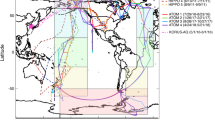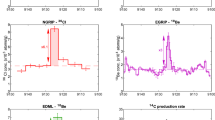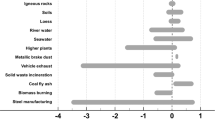Abstract
The measurement of iridium (Ir) in atmospheric samples is important because it gives information on the short-term flux of extraterrestrial material without interference from fragmentation products from large bodies. Such information cannot be obtained from sediment samples, because sediment samples integrate over millions of years and include contributions of large bodies impacted in that time period. In addition to flux information, through the analysis of Ir in atmospheric samples we can also evaluate a possible contribution of extraterrestrial material to the unusual enrichment of chalcophilic elements in a remote atmosphere. We present here a determination of average particle-borne Ir concentration in the South Pole atmosphere. The average values of (7.3±3.1)×l0–17g m–3 suggests that the concentration of extraterrestrial material in the South Pole atmosphere is not large enough to explain the enrichments of anomalously enriched elements; however, meteoritic material contributes significantly to the observed concentrations of Co, Fe and Mn. We estimate an accretion rate for background extraterrestrial material of 11,000 tons annually.
This is a preview of subscription content, access via your institution
Access options
Subscribe to this journal
Receive 51 print issues and online access
$199.00 per year
only $3.90 per issue
Buy this article
- Purchase on Springer Link
- Instant access to full article PDF
Prices may be subject to local taxes which are calculated during checkout
Similar content being viewed by others
References
Lal, D., Peters, B. in Handbuch Der Physik Vol. 46(2) 551–612 (ed. Flugge, S.) (Springer, Berlin, 1967).
Cunningham, W. C. & Zoller, W. H. J. Aerosol Sci. 12, 367–384 (1981).
Maenhaut, W., Zoller, W. H. & Coles, D. G. J. geopys. Res. 84, 2421–2431 (1979).
Zoller, W. H., Parrington, J. R., Kotra, J. M. P. Science 222, 1118–1121 (1983).
Tuncel, G. thesis, Univ. Maryland (1985).
Parkin, D. W. & Tilles, D. Science 159, 936–946 (1968).
Fenner, F. D. & Presley, B. J. Nature 312, 260–263 (1984).
Taylor, S. R. Geochim. cosmochim. Acta 28, 1273–1285 (1972).
Crocket, J. H. & Kuo, H. Y. Geochim. cosmochim. Acta 43, 831–842 (1979).
Boutron, C. & Lorius, C. Nature 277, 1–3 (1979).
Legrand, M. R. & Delmas, R. J. Atmos. Environ. 18, 1867–1874 (1984).
Kumai, M. J. atmos. Sci. 33, 833–841 (1976).
Turco, R. P., Toon, O. B., Hammil, P. & Whitten, R. C. J. geophys. Res. 86, 1113–1128 (1981).
Sulek, A., M.S. thesis, Univ. Maryland (1979).
Thompson, L. G. & Thompson, E. M. Science 212, 812–814 (1981).
Mason, B. US geol. Surv. Prof. Pap. 440-8-1, (1979).
Brocas, J. & Piciotto, E. J. geophys. Res. 72, 2229–2236 (1967).
Bibron, R. R. et al. Earth planet. Sci. 21, 109–116 (1974).
Ganapathy, R. Science 220, 1158–1161 (1983).
Uematsu, M. & Duce, R. A. Nature (in the press).
Takahashi, H., Yokoyoma, Y., Fireman, E. L. & Lorius, C. Lunar planet. Sci. 9, 1131–1133 (1979).
Hughes, D. W. in Cosmic Dust (ed. McDonnell, J. A. M.) 123 (Wiley, Chichester, 1978).
Kyte, F. T. & Wasson, J. T. Science 232, 1225 (1986).
Gran, E., Zook, H. A., Fechtig, H. & Giese, R. H. Icarus 62, 244 (1982).
Murrel, M. T., Davis, P. A., Nishisumi, K. & Millard, H. T. Geochim. cosmochim. Acta 44, 2067–2074 (1980).
McGorkell, R., Fireman, E. L. & Langway, C. C. Science 156, 1690–1692 (1967).
Mulotak, V. I. Kosmokhim. Metroid. 6th Mater. Vses. Symp. 64–72 (1982).
Shedlowsky, J. P. & Paisley, S. Tellus 18, 499–503 (1966).
Patterson, H. & Rostchi, H. Geochim. cosmochim. Acta 2, 81–90 (1952).
Bonner, F. T. & Laurenco, A. S. Nature 207, 933–935 (1965).
Harris, R. C., Crockett, J. H. & Stainton, M. Geochim. cosmochim. Acta 32, 1049–1056 (1968).
Barker, J. L. & Anders, E. Geochim. cosmochim. Acta 32, 627–645 (1968).
Ozima, M., Tagayanagi, M. & Zashu, S. Nature 311, 448–450 (1984).
Author information
Authors and Affiliations
Rights and permissions
About this article
Cite this article
Tuncel, G., Zoller, W. Atmospheric iridium at the South Pole as a measure of the meteoritic component. Nature 329, 703–705 (1987). https://doi.org/10.1038/329703a0
Received:
Accepted:
Issue Date:
DOI: https://doi.org/10.1038/329703a0
This article is cited by
Comments
By submitting a comment you agree to abide by our Terms and Community Guidelines. If you find something abusive or that does not comply with our terms or guidelines please flag it as inappropriate.



